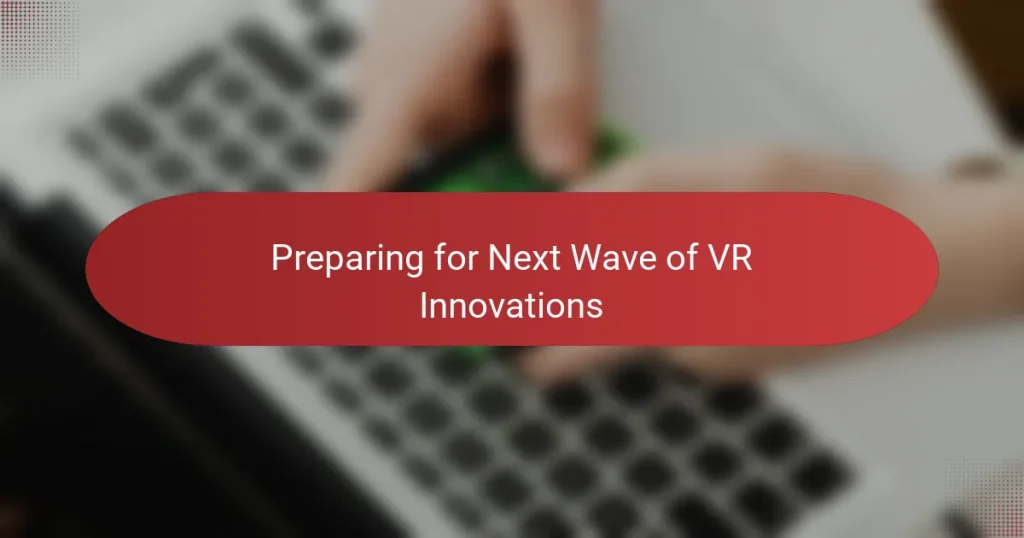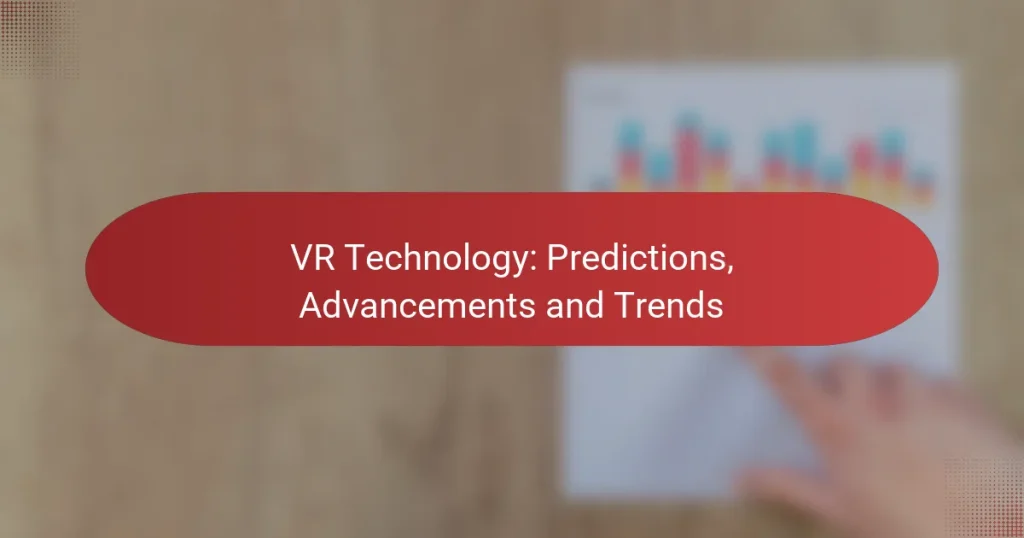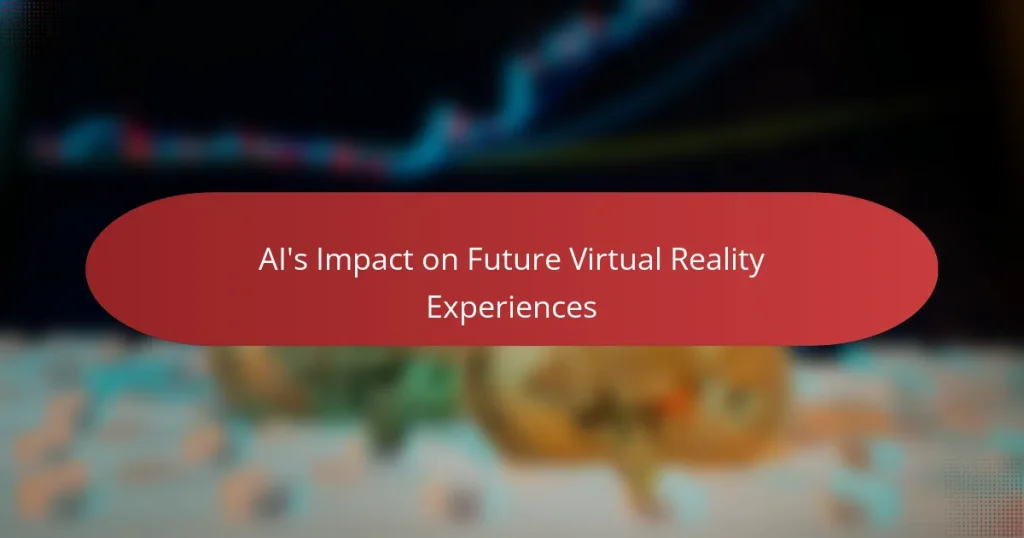The future of virtual reality (VR) is poised to revolutionize multiple sectors, particularly in entertainment and education. As advancements in technology continue to emerge, VR is set to create more immersive experiences, transforming how users engage with content and learn complex concepts. With the integration of artificial intelligence and improved hardware, the possibilities for VR applications are expanding rapidly.
VR Technology: Predictions, Advancements and Trends
AI’s Impact on Future Virtual Reality Experiences
Emerging VR Platforms: Comparison, Features and Impact
What are the future applications of virtual reality in entertainment?
The future applications of virtual reality (VR) in entertainment are vast and varied, focusing on creating engaging and immersive experiences. These applications range from gaming and live events to innovative storytelling methods, transforming how audiences interact with content.
Immersive gaming experiences
Immersive gaming experiences in VR allow players to step into virtual worlds and interact with them in a way that traditional gaming cannot match. Players can explore expansive environments, solve puzzles, and engage in combat, all while feeling a sense of presence that enhances gameplay.
Popular VR games often incorporate physical movement, requiring players to use their bodies to navigate and interact. Titles like “Beat Saber” and “Half-Life: Alyx” exemplify how VR can create engaging gameplay that feels both intuitive and exhilarating.
Virtual concerts and events
Virtual concerts and events leverage VR technology to bring live performances to audiences worldwide, regardless of location. These events can range from intimate gatherings to large-scale festivals, allowing fans to experience performances as if they were there in person.
Platforms like Oculus Venues and Wave have pioneered this space, offering features such as social interaction, customizable avatars, and immersive environments. Attendees can enjoy a front-row experience from their homes, often with options for different camera angles and interactive elements.
Interactive storytelling
Interactive storytelling in VR enables users to become part of the narrative, making choices that influence the outcome of the story. This approach transforms traditional storytelling into a participatory experience, engaging audiences on a deeper level.
Examples include VR films and experiences where viewers can explore environments and interact with characters. Projects like “The Invisible Hours” and “Wolves in the Walls” showcase how VR can create compelling narratives that adapt based on user decisions, offering a unique experience with each viewing.
How is virtual reality transforming education in the UK?
Virtual reality (VR) is significantly reshaping education in the UK by providing immersive learning experiences that enhance engagement and understanding. Through VR, students can explore complex concepts and environments in a way that traditional methods cannot achieve.
Virtual classrooms
Virtual classrooms leverage VR technology to create interactive learning environments where students can attend classes from anywhere. This setup allows for real-time collaboration between teachers and students, fostering a sense of community even when participants are physically distant.
Institutions can utilize platforms that support VR classrooms, enabling features like 3D presentations and virtual field trips. This approach can be particularly beneficial for remote areas in the UK, where access to quality education may be limited.
Simulations for practical training
VR simulations provide students with hands-on training in a controlled environment, which is especially valuable for fields like medicine, engineering, and aviation. For instance, medical students can practice surgical procedures in a virtual setting, reducing the risk associated with real-life practice.
These simulations can replicate real-world scenarios, allowing learners to make mistakes and learn from them without real-world consequences. This method not only enhances skill acquisition but also builds confidence before entering the workforce.
Enhanced learning experiences
Enhanced learning experiences through VR can lead to improved retention and understanding of complex subjects. Students can visualize abstract concepts, such as molecular structures in chemistry or historical events in history, making learning more engaging and effective.
Moreover, VR can cater to different learning styles, offering auditory, visual, and kinesthetic experiences. Educators should consider integrating VR into their curricula to take advantage of these diverse learning opportunities, ensuring that lessons are memorable and impactful.
What are the key trends in virtual reality technology?
Key trends in virtual reality technology include advancements in hardware, integration with artificial intelligence, and improved user interfaces. These developments are enhancing the overall VR experience, making it more immersive and accessible for users across various sectors.
Advancements in hardware
Recent advancements in hardware are significantly improving the performance and accessibility of virtual reality systems. New headsets feature higher resolution displays, reduced latency, and improved field of view, making experiences more lifelike. For example, many modern VR headsets now offer resolutions exceeding 2000 x 2000 pixels per eye.
Additionally, the introduction of standalone VR devices eliminates the need for powerful external computers, allowing users to enjoy VR experiences anywhere. This trend is particularly beneficial for gaming and training simulations, where mobility and ease of use are essential.
Integration with artificial intelligence
Artificial intelligence is increasingly being integrated into virtual reality to create more responsive and adaptive environments. AI can enhance user interactions by personalizing experiences based on individual preferences and behaviors. For instance, AI-driven NPCs (non-player characters) in VR games can learn from player actions, providing a more engaging and dynamic gameplay experience.
Moreover, AI can streamline content creation for VR environments, allowing developers to generate realistic simulations more efficiently. This integration is expected to reduce development costs and time, making VR more accessible to a broader range of industries.
Improved user interfaces
User interfaces in virtual reality are evolving to become more intuitive and user-friendly. Gesture recognition, voice commands, and haptic feedback are becoming standard features, allowing users to interact with virtual environments more naturally. This shift is crucial for applications in education and training, where ease of use can significantly impact learning outcomes.
Furthermore, the development of cross-platform compatibility is enhancing user experience by allowing seamless transitions between different devices and environments. As interfaces become more standardized, users can expect a smoother and more cohesive VR experience across various applications.
How is virtual reality being used in healthcare?
Virtual reality (VR) is increasingly utilized in healthcare for enhancing patient care, training medical professionals, and providing therapeutic solutions. Its immersive nature allows for realistic simulations and interactive experiences that can improve outcomes in various medical fields.
Patient treatment simulations
Patient treatment simulations using VR allow healthcare providers to create realistic scenarios for diagnosing and treating conditions. For instance, VR can simulate surgeries or emergency situations, enabling practitioners to practice procedures without risk to real patients. This method can significantly enhance decision-making skills and procedural knowledge.
Additionally, VR can help patients visualize their treatment plans, making them more engaged and informed about their healthcare journey. This can lead to better adherence to treatment protocols and improved patient satisfaction.
Medical training and education
In medical training, VR offers a safe environment for students and professionals to hone their skills. It allows for repetitive practice of complex procedures, which is crucial for building confidence and competence. Medical schools are increasingly incorporating VR into their curricula to provide hands-on experience without the need for cadavers or live patients.
Moreover, VR can facilitate remote learning, enabling students to participate in simulations from anywhere. This flexibility can be particularly beneficial in rural areas where access to training facilities may be limited.
Therapeutic applications
VR is also making strides in therapeutic applications, particularly in mental health. It can be used for exposure therapy in treating phobias, PTSD, and anxiety disorders by immersing patients in controlled virtual environments that trigger their fears in a safe manner. This exposure can help patients gradually confront and manage their anxieties.
Furthermore, VR is being explored for pain management, where immersive experiences can distract patients during painful procedures or chronic pain episodes. Studies suggest that patients using VR for pain relief report lower pain levels and a more positive overall experience.
What are the challenges facing virtual reality adoption?
The adoption of virtual reality (VR) faces several significant challenges that hinder its widespread use. These challenges include high costs of equipment, barriers to content creation, and issues with user accessibility.
High costs of equipment
The high costs associated with VR equipment remain a primary barrier to adoption. Quality VR headsets can range from several hundred to over a thousand USD, making them less accessible to average consumers. Additionally, powerful computers or consoles are often required to run VR applications effectively, further increasing the financial burden.
To mitigate these costs, consumers can look for budget-friendly options or consider second-hand devices. However, it’s essential to ensure that these alternatives still meet performance standards for an optimal VR experience.
Content creation barriers
Creating content for VR can be complex and resource-intensive, which poses a challenge for developers. The need for specialized skills, software, and hardware can deter many potential creators. Additionally, the current market for VR content is still developing, which can make it difficult for creators to justify the investment.
To overcome these barriers, aspiring developers should leverage existing platforms that provide tools and resources for VR content creation. Collaborating with others in the industry can also help share knowledge and reduce individual workload.
User accessibility issues
User accessibility is a significant concern in the VR landscape, as not all individuals can easily use VR technology. Factors such as physical disabilities, age, and even motion sickness can limit who can effectively engage with VR experiences. This can lead to a lack of inclusivity in VR applications.
To improve accessibility, developers should prioritize designing user-friendly interfaces and consider implementing features that accommodate various needs. Offering adjustable settings for comfort and usability can help make VR more accessible to a broader audience.
What are the ethical considerations in virtual reality?
Ethical considerations in virtual reality (VR) encompass issues related to user privacy, psychological effects, and the potential for addiction. As VR technology evolves, addressing these concerns becomes crucial to ensure safe and responsible usage.
Privacy and Data Security
Privacy in virtual reality is a significant concern due to the vast amounts of personal data collected during immersive experiences. Users often share biometric information, preferences, and behavioral patterns, which can be exploited if not adequately protected. Companies must implement robust data security measures to safeguard user information.
To enhance privacy, users should be informed about what data is collected and how it is used. Opting for platforms that prioritize user consent and transparency can mitigate risks associated with data breaches and misuse.
Psychological Impact
The psychological effects of virtual reality can vary widely, with some users experiencing heightened emotions or even distress during immersive experiences. VR can create realistic scenarios that may trigger anxiety or trauma, especially in sensitive contexts. Developers need to consider these impacts when designing content.
It is essential for users to take breaks and monitor their emotional responses while using VR. Engaging with content that promotes positive experiences can help minimize adverse psychological effects.
Addiction and Overuse
Addiction to virtual reality can be a concern, particularly as immersive experiences become more engaging. Users may find it challenging to balance their time between VR and real-life responsibilities, leading to potential neglect of social interactions and physical health. Awareness of this risk is vital for both developers and users.
To prevent overuse, users should set time limits for VR sessions and engage in regular physical activities outside of virtual environments. Developers can also incorporate reminders or breaks within the VR experience to encourage responsible usage.



